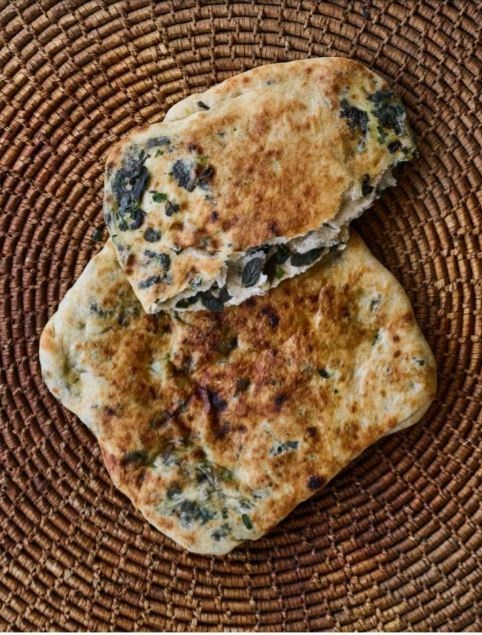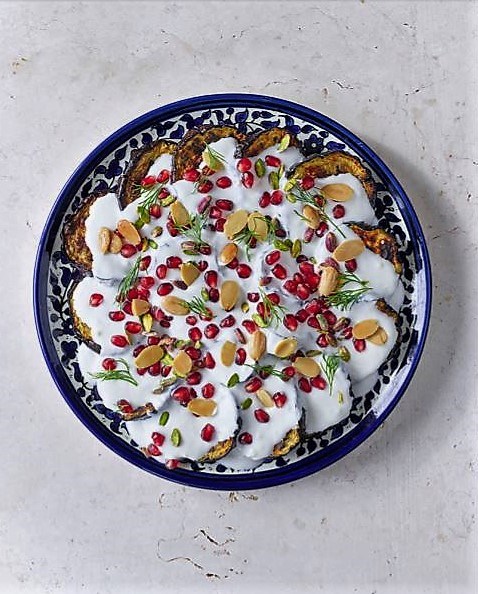Recipes from The Palestinian Table
March 19, 2018 by JennyPhaidon creates books that ushers readers around the globe through stunning photographs, beautiful stories and recipes. We are able to experience myriad cultures and traditions through their pages bringing us all just a little bit closer.
One such title is Reem Kassis’ James Beard nominated, The Palestinian Table. Here Reem weaves together personal anecdotes, traditions and history so that we may experience her Palestine. With delicious, easy-to-follow recipes that range from simple breakfasts and speedy salads to celebratory dishes fit for a feast, she gives a rare insight into the heart and hearth of the Palestinian family kitchen. The dishes are accompanied by full page photographs as well as a sprinkling of images of the people and marketplaces of this area.
Today we have three recipes from The Palestinian Table for you to try courtesy of Phaidon. Add them to your bookshelf to try soon.
Please remember that members of Eat Your Books receive a 30%
discount when ordering Phaidon titles using this link.

Za’atar filled flatbreads
Add this recipe to your Bookshelf (click the blue +Bookshelf
button).
Preparation Time: 40 minutes + resting time
Cooking Time: 7-12 minutes
Makes 10
One of the oldest and most traditional Palestinian pastries, these flatbreads, as well as being delicious, have an emotional significance for my family. My mother’s uncle, Yousef, was forced into political exile at twenty. The next time he saw anyone from his family was two decades later when my mother traveled to the United States. He had one request – to bring him some of his mother’s akras za’atar.
Ingredients
For the pastry
• 4 ½ cups (1 lb 2 oz/500 g) all-purpose (plain) flour, plus
extra for dusting
• 2 ¼ cups (9 oz/250 g) fine whole wheat (wholemeal) flour
• 2 teaspoons salt
• 1 teaspoon sugar
• 2 tablespoons olive oil, plus extra for oiling
• 1 tablespoon active dry (fast-action) yeast
• 2-2 ½ cups (18-20 fl oz/500-600 ml) warm water
For the filling
• 2 cups (3 ½ oz/100 g) firmly packed fresh za’atar leaves (or
substitute with fresh oregano and/or marjoram and thyme
leaves)
• 8 scallions (spring onions), green and white parts finely
chopped
• 1 teaspoon salt
• ½ cup (4 fl oz/120 ml) olive oil
• ¼ teaspoon black pepper
Instructions:
Put the flours, salt, and sugar into a bowl and mix together. Make a well in the middle; add the oil, yeast, and half the water. Mix through with your fingers, adding more water and kneading until the dough comes together. If the mixture feels sticky, leave for 5 minutes then knead again. Repeat until you have a soft ball of dough. Alternatively, combine all the ingredients, but only half the water, in the bowl of a freestanding mixer fitted with the dough hook and mix on medium speed, adding water as necessary, until it comes together in a soft but robust ball. Rub with oil, cover the bowl with a damp dish towel, and set aside to rise for 1 hour.
Meanwhile, prepare the stuffing by placing all the filling ingredients into a large bowl and tossing to combine. Set aside until ready to use.
Once the dough has risen, divide into 10 equal-sized portions. Line a large tray with oiled plastic wrap (clingfilm). Place the dough on the tray. Let rest for 5-10 minutes.
Take one portion of dough and, with your hands, flatten it into a rough circle. Take about a tenth of the filling and spread it evenly over the pastry. Starting at the top use both hands to fold the pastry into thirds, oiling each layer as you fold. You should now have a long rectangle. Take one of the short sides and fold into thirds again, this time horizontally, oiling each layer as you go. You should now have a square shape. Oil the pastry again and set aside on an oiled surface and cover with oiled plastic wrap. Repeat with remaining pastry. Set aside to rest for 15 minutes while you preheat the oven to 475°F/240°C/Gas Mark 9.
Flatten it out with well oiled hands into a 8-inch/20-cm square, then place on a baking sheet. Repeat with the rest of the pastry. Bake for 7-12 minutes, or until a light golden color. Check the underside, if it has not browned, you may need to flip it and bake for 2 minutes to brown the bottom.
Remove from the oven and transfer to a wire rack to cool. Serve
warm with halloumi cheese or Labaneh (page 26), a side of fresh
vegetables, and a cup of sweet mint tea (page 237).

Preparation Time: 15 minutes
Cooking Time: 20 minutes
Serves: 4-6
Ingredients
• 2 ¼ lb/1 kg (about 4 medium) eggplants (aubergines)
• olive oil, for brushing
• salt and black pepper
For the yogurt sauce
• 1 ½ cups (14 oz/400 g) Greek yogurt
• 1 small clove garlic, crushed
• ½ teaspoon salt
• ½ teaspoon lemon juice (optional)
For the garnish
• 2 tablespoons pomegranate seeds
• ½ cup (2 oz/50 g) lightly toasted mixed nuts, such as almonds,
pistachios, hazelnuts
• small handful of green leaves such as arugula (rocket), dill, or
chives
Instructions
Preheat the broiler (grill) to high. Slice the eggplants (aubergines) into ¾-inch/1.5-cm rounds, brush both sides with olive oil, and sprinkle with salt and pepper. Place the eggplants on an oven rack and broil (grill) for about 10 minutes on each side, or until they develop a golden brown exterior.
In the meantime, put all the ingredients for the yogurt sauce into a bowl and whisk together to a smooth consistency. The lemon juice is optional but it helps bring all the flavors together, especially if you are using a mellow yogurt, not a tangy one.
Once the eggplants are done, arrange in overlapping circles on a round platter. Spoon over the yogurt mixture then top with pomegranate seeds, toasted nuts, and green leaves.
Variation: Use zucchini (courgettes), cut in half and sliced lengthwise, instead of the eggplants and use walnuts, pomegranate seeds, and sumac for the garnish.

Jerusalem sesame bagels
Add this recipe to your Bookshelf (click the blue +Bookshelf
button).
Preparation Time: 30 minutes +
resting
Cooking Time:15 – 20 minutes
Makes: 6 bagels
Ingredients
For the Pastry
- 4 ½ cups (1 lb 2 oz / 500 g) all-purpose (plain) white flour
- 2 tablespoons sugar
- 2 teaspoons salt
- 1 ½ cups (12 fl oz / 350 ml) whole (full-fat) milk, warm
- 1 tablespoon active dry (fast-action) yeast
- 1 teaspoon baking powder
- olive oil
For the sesame coating
- 1 cup (5 oz / 150 g) hulled sesame seeds
- 1 – 2 tablespoons grape molasses
Instructions
Put all the dough ingredients except the olive oil into the bowl of a freestanding mixer fitted with the dough hook. Mix on medium speed until the dough comes together in a soft and pliable ball. Alternatively, mix in a large bowl and knead by hand until smooth and pliable. If the mixture appears too stiff, add a little milk and continue to knead. You are looking for a soft, elastic but robust dough. Rub with oil, cover the bowl with a damp dish towel or plastic wrap (clingfilm), and set aside to rise until doubled in size, about 1 hour.
Meanwhile, prepare the sesame coating. In a large shallow bowl, combine the sesame seeds and grape molasses with 1 tablespoon of water. Mix, adding more water as necessary, until you have a wet mixture that is neither too sticky and thick that it clumps up, nor too thin. You just want to be able to coat the dough in the seeds and have them stick.
Once the dough has risen, gently punch down to release the air bubbles. Divide into 6 equal-sized portions and place on a lightly floured work surface. Roll and stretch each piece into a log about 8-12 inches/20-30 cm long, then attach the ends together to form a circle. Set aside to rest for 15 minutes.
Preheat the oven to 450°F/230°C/Gas Mark 8. Take each dough ring, dip it in the sesame mixture, and gently roll and stretch the ring until you have a long oval shape, similar to a stretched out “0”. Repeat with each ring, then set aside on a baking sheet to rest a final time, about 10 minutes.
Place the baking sheet or sheets into the oven and bake for 15-20 minutes, or until a deep golden color and cooked through. Set aside on a wire rack to cool.
Serve warm with some za’atar, or white cheese and vegetables, and sweet tea. Freeze any leftovers for up to 1 month and reheat in oven before serving.
Special thanks to Phaidon and Reem Kassis for sharing these recipes with our members from The Palestinian Table. ©2017 Photograph credit Dan Perez.
Categories
- All Posts (7078)
- Antipasto (2208)
- Author Articles (250)
- Book News (944)
- Cookbook Giveaways (996)
- Cookbook Lovers (262)
- Cooking Tips (116)
- Culinary News (299)
- Food Biz People (558)
- Food Online (800)
- Holidays & Celebrations (277)
- New Cookbooks (154)
- Recipes (1520)
- Shelf Life With Susie (231)
- What's New on EYB (134)
Archives
Latest Comments
- fluffies on For the Love of Lemons by Letitia Clark – Giveaway
- Goulashgirl on Any way you slice it
- ChefClaireFVS on French at Heart – Cookbook Giveaway
- ChefClaireFVS on 20 Amici – 40 Ricette Cookbook Giveaway
- kitchen_chick on Salt Sugar MSG Cookbook Giveaway
- kitchen_chick on Balli Balli – Cookbook Giveaway and Quick Bites
- SCH on Introducing libraries to EYB at ALA
- FrenchCreekBaker on Four outstanding independently published cookbooks worth your attention
- breakthroughc on Any way you slice it
- Marymac54 on French at Heart – Cookbook Giveaway
